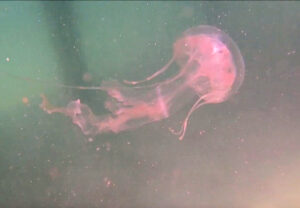Pacific Sea Nettle, Chrysaora fuscescens
 Pacific Sea Nettle, Chrysaora fuscescens. Underwater photograph taken in Zihuatanejo Bay, Guerrero, February 2019. Photograph courtesy of Ron Woheau, Zihuatanejo.
Pacific Sea Nettle, Chrysaora fuscescens. Underwater photograph taken in Zihuatanejo Bay, Guerrero, February 2019. Photograph courtesy of Ron Woheau, Zihuatanejo.
Phylogeny: The Pacific Sea Nettle, Chrysaora fuscescens (Brandt, 1835), is a member of the Pelagiidae Family of Pelagiid Jellyfish and the Class Scyphozoan of true jellies. It is also known as the Brown Sea Nettle and in Mexico as medusa ortiga café. There are presently fifteen recognized species in the genus Chrysaora.
Morphology: The Pacific Sea Nettle has a bell that is amber, brown, or reddish in color, usually with a darker margin. Some have a visible lighter colored star pattern on the outer surface of the bell. They have 24 brown, reddish, or maroon colored tentacles distributed around the margin of the bell. The oral arms may be pink, yellowish-brown, or reddish-brown in color. The bell can reach up to 30 cm (12 inches) in diameter, though most are smaller. The oral arms may reach 4.6 m (15 feet) in length. To migrate towards the surface, they use light sensing organs called oceli.
Habitat and Distribution: Pacific Sea Nettles are found in the pelagic zone, and in bays and estuaries. They are normally found in the first 20 m (66 feet) of the water column. The Brown Sea Nettles are found across the Northern Pacific Ocean, from Japan to California, extending from the Gulf of Alaska down to Mexico. They are less common in Mexican waters, typically limited to the central and northern coasts.
Diet: The Pacific Sea Nettles feed on cephalopods, ctenophores, crustaceans, other jellyfish and pelagic snails by paralyzing prey with nematocysts in the tentacles. When prey brushes against the tentacles, the nematocysts launch barbed stingers that release a paralyzing toxin into the prey.
Predators: The Pacific Sea Nettles are preyed upon by sea birds, such as the Northern Fulmar, and fish.
Reproduction: In the medusa stage, the Pacific Sea Nettle sexually reproduces via broadcast spawning, where the females capture floating sperm to fertilize their eggs. Asexual reproduction occurs in the polyp stage, where budding creates genetically identical offspring.
Ecosystem Interactions: Pacific Sea Nettles often play host to commensal or parasitic hitchhikers including crustaceans and fish.
Human Interaction: Pacific Sea Nettles are considered dangerous to humans as they are capable of delivering a painful sting to humans. Large concentrations of these jellyfish can clog fishing nets and water intake pipes. Mass strandings of up to 1,000,000 individuals, have been documented.
Synonyms: Chrysaora helvola